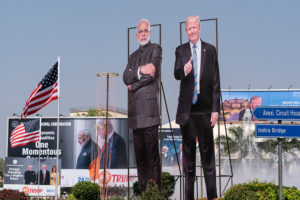Where Was Trump on Mob Violence against Muslims in Delhi? Close but So Far Away.
 Large cardboard cut-outs of President Trump and Indian Prime Minister Narendra Modi are seen Monday, Feb. 24, 2020, along the motorcade route in Ahmedabad, India. (Official White House Photo by Andrea Hanks)
Large cardboard cut-outs of President Trump and Indian Prime Minister Narendra Modi are seen Monday, Feb. 24, 2020, along the motorcade route in Ahmedabad, India. (Official White House Photo by Andrea Hanks) Humanists should be alarmed by the extreme violence directed at Muslims in India. Despite President Trump’s praise, during his state visit to the country in late February, of Indian Prime Minister Narendra Modi for “working very hard on religious freedom,” the truth is a bit different. Modi is working hard to quash the religious freedom for followers of Islam.
Some 200 million Muslims in India face discrimination since parliament in the Hindu-majority nation passed the Citizenship Amendment Act (CAA) in December. The law allows Modi’s government to create a path toward citizenship for immigrants of different faiths—unless they identify as Muslim. Even prior to this act, there was strong reason to believe that Modi infringed upon religious freedom and rights under his Hindu nationalist agenda. The violence that took place in Delhi around the time of Trump’s visit was a culmination of months of protests against the CAA and clashes between supporters and opponents, the latest in a long series of actions against Muslims since 2014, when Modi first came to power.
And yet it was the worst religious violence the city has seen in decades. As reported by CBC News:
Mosques, schools, homes, and businesses were torched and looted by violent mobs, mostly targeting Muslims. Bodies were still being recovered from sewer drains more than a week after the violence, and officials say more than fifty are dead and more than 200 people were injured.
The truth remains that anti-Muslim violence has been commonplace on the subcontinent in the form of lynching, shaming, and more. With Modi’s re-election last summer, the discrimination and violence against Muslims has only increased, and his Hindu nationalist Bharatiya Janata Party (BJP) seems bent on advancing a stronger Hindu nationalist agenda.
For many Indians, the February clashes in Delhi were no surprise; Hindu nationalism was bound to provoke sectarian violence—it was just a matter of when. What’s alarming is that Trump chose not to speak out about it when he was just a few miles away from where it was happening. Trump has been sidestepping the citizenship law but by choosing to praise Modi for his dedication to religious freedom, was he really praising what was being done to Muslims in the streets nearby?
Modi and the BJP-led government have created a dangerous, toxic environment, allowing religious intolerance and persecution through state-sanctioned laws and Hindu nationalist, anti-Muslim rhetoric. The violence in Delhi was no accident. It was systematically well-executed to target Muslim-owned businesses, households, and more. Also worth considering is how the Jammu and Kashmir region, India’s only Muslim-majority state, was stripped of its semi-autonomous status back in August. It seems the BJP is going to get successively bolder in their actions against Muslims.
Since the February mob riots, hundreds of Muslims have fled the city out of fear. While Modi publicly condemned the violence on February 26 on Twitter, stating that “Peace and harmony are central to our ethos. It is important that calm and normalcy is restored at the earliest,” it doesn’t change his anti-Muslim actions, nor does it really attempt any reconciliation between Hindu and Muslim communities.
Also disturbing was Trump’s rhetoric during his time in India that focused on US immigration and border security. This hinted indirect support for Modi’s actions, likely a strategic act on Trump’s part to improve US-India relations. However, as the president of the United States, he holds an incredible amount of influential power, and in the interest of promoting democracy, he should condemn the actions of Modi and the BJP.
